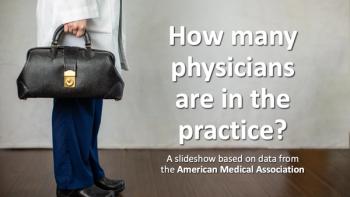
Treatment Goals and Guidelines in Type 2 Diabetes with Cardiovascular Disease
Diana Isaacs, PharmD, BCPS, BCACP, BC-ADM, CDCES, discusses goals of therapy in diabetic patients with cardiovascular disease and Robert Busch, MD, provides an overview of diabetes treatment guidelines.
Episodes in this series

Dhiren Patel, PharmD, CDE, BC-ADM, BCACP: What I want to do now is shift gears and talk a little bit about treatment goals. I mentioned earlier that it’s nice to see some of our guidelines now that are more similar, but not in the years past. It was like, well, this guideline says this, but this guideline says this, and I think many of you guys agree. Now I think even the body, they’re doing a better job of coordinating it, saying it’s also been endorsed by so-and-so guideline.
But maybe walk me through, and Dr. Isaacs, we’ll start with you, regarding the treatment goals of patients with type 2 diabetes and their associated cardiovascular risk. Maybe what I’ll do here is have you talk a little bit about the ADA [American Diabetes Association] guidelines; Dr. Busch, maybe you can give your perspective from the AACE [American Association of Clinical Endocrinology] guidelines and from the endocrinologist perspective; and we’ll end with the cardiology perspective from the ACC [American College of Cardiology] standpoint. I know we’re going to probably cover some of the same topics, but, again, it’s nice to be in a place where there’s alignment because it’s less confusion, and we’re hoping that this is going to translate into better patient outcomes. Dr. Isaacs, maybe if you want to start with the ADA guidelines.
Diana Isaacs, PharmD, BCPS, BCACP, BC-ADM, CDCES: Sure. I am a good person to do this because I’m currently on their professional practice committee, so we’ve had a lot of discussion about this. So, yeah, current guidelines for 2021 are A1C target is still less than 7%, although that should be individualized, and metformin is still considered the first-line medication. But what’s really different that was changed for 2021, is that irrespective of A1C target, SGLT-2 [sodium-glucose cotransporter-2] inhibitors and GLP-1 [glucagon-like peptide-1] receptor agonists are recommended based on if they’re high cardiovascular risk or they have established cardiovascular disease. So that was a big change basically saying, yeah, we have these A1C targets, but really we know these drugs are so beneficial, that it doesn’t matter. Someone’s A1C could already be at target, but we should be considering these agents.
I’ll tell you, there’s a lot of discussion right now not just within ADA, but everywhere, about what is even metformin’s role, right, because metformin has long been first-line and it is effective, it is cheap compared to our newer agents. But now that we have this established, all this evidence about the cardiovascular reduction, should metformin, should patients have to start with metformin before going on to these other agents? So that’s a fun direction that guidelines are going.
Dhiren Patel, PharmD, CDE, BC-ADM, BCACP: Dr. Busch, as you talk about it, it would be nice if you could add a little bit of cover not only of the guidelines, but some of the benefits of this CV [cardiovascular] risk reduction that you’re starting to see as newer information is being factored in. It’s not just from a glucose-centric standpoint, you’re starting to see additional language especially in the AACE guidelines of some of their recommendations, and they’ve always been a bit more aggressive. But maybe if we can walk through the AACE guidelines, that would be great.
Robert Busch, MD: The AACE guidelines, when it was just A1C goal, was 6.5, and they had a batting order of the drugs. You wanted to stay away from drugs that could cause hypoglycemia, and you wanted to utilize drugs that had weight loss as an additional benefit. The guidelines were metformin, then GLP-1, and then SGLT-2, whereas a lot of our colleagues still use a lot of DPP-4s [dipeptidyl peptidase 4] because they’re easy to use. But they don’t have cardiac benefits. They don’t have weight loss that a GLP-1 has. And the cardiac issues. Basically it’s metformin, GLP-1, SGLT-2, would be the batting order. No hypoglycemia, weight loss from all 3 types of drugs and you don’t have to worry about hypoglycemia.
But I think AACE is also very respective of what the different outcome studies have done, and it wasn’t until EMPA-REG came out that it showed in cardiac patients, it lowered cardiac death 38% and MI stroke and death to 14%, and canagliflozin lowered MI/stroke death in their outcome study, although not one thing drove the outcome. But dapagliflozin had a lot more modified study for primary prevention as well. It was safe in terms of MI/stroke death, but beneficial in terms of heart failure prevention even in the patient with diabetes who did not have cardiac disease in the past. Then, of course, the GLPs had their outcome studies. Liraglutide in the LEADER trial and semaglutide in the SUSTAIN trial lowered MI/stroke death, and interestingly, semaglutide lowered stroke which drove that outcome. And then dulaglutide used in primary prevention as well as secondary, lowered MI/stroke death 12%, predominantly the stroke benefit.
So we have 2 classes of drugs that we utilize a lot of, SGLT-2 and GLP-1. And as Dr. Isaacs said, the SGLT-2 we use more frontline if a patient had a history of kidney disease, which we’ll talk about as well, or heart failure. Whereas the GLP-1, if they purely had an ASCVD [atherosclerotic cardiovascular disease], you might prefer the GLP-1, although the SGLT-2 would be beneficial there as well.
Transcript edited for clarity.
Newsletter
Stay informed and empowered with Medical Economics enewsletter, delivering expert insights, financial strategies, practice management tips and technology trends — tailored for today’s physicians.












